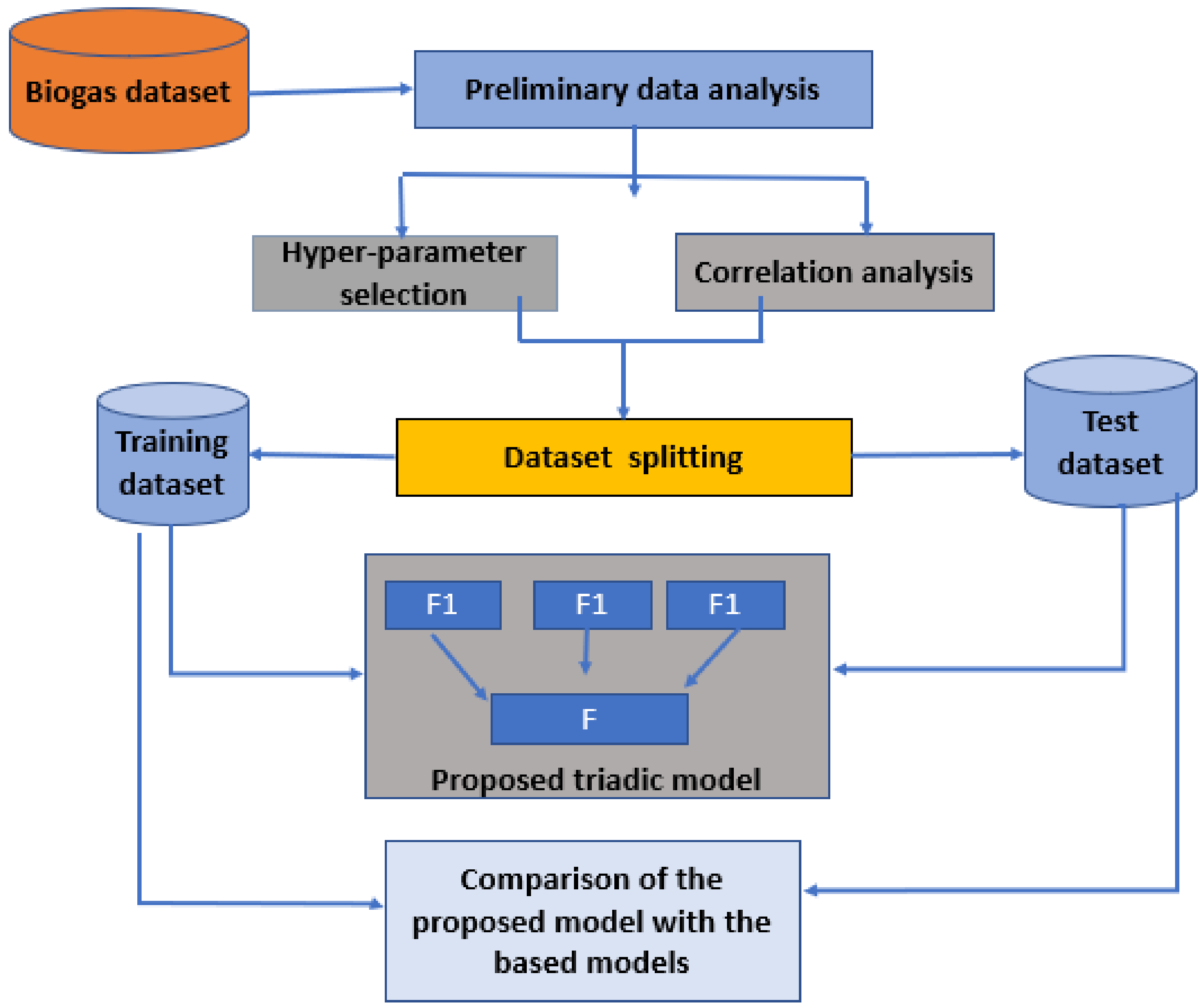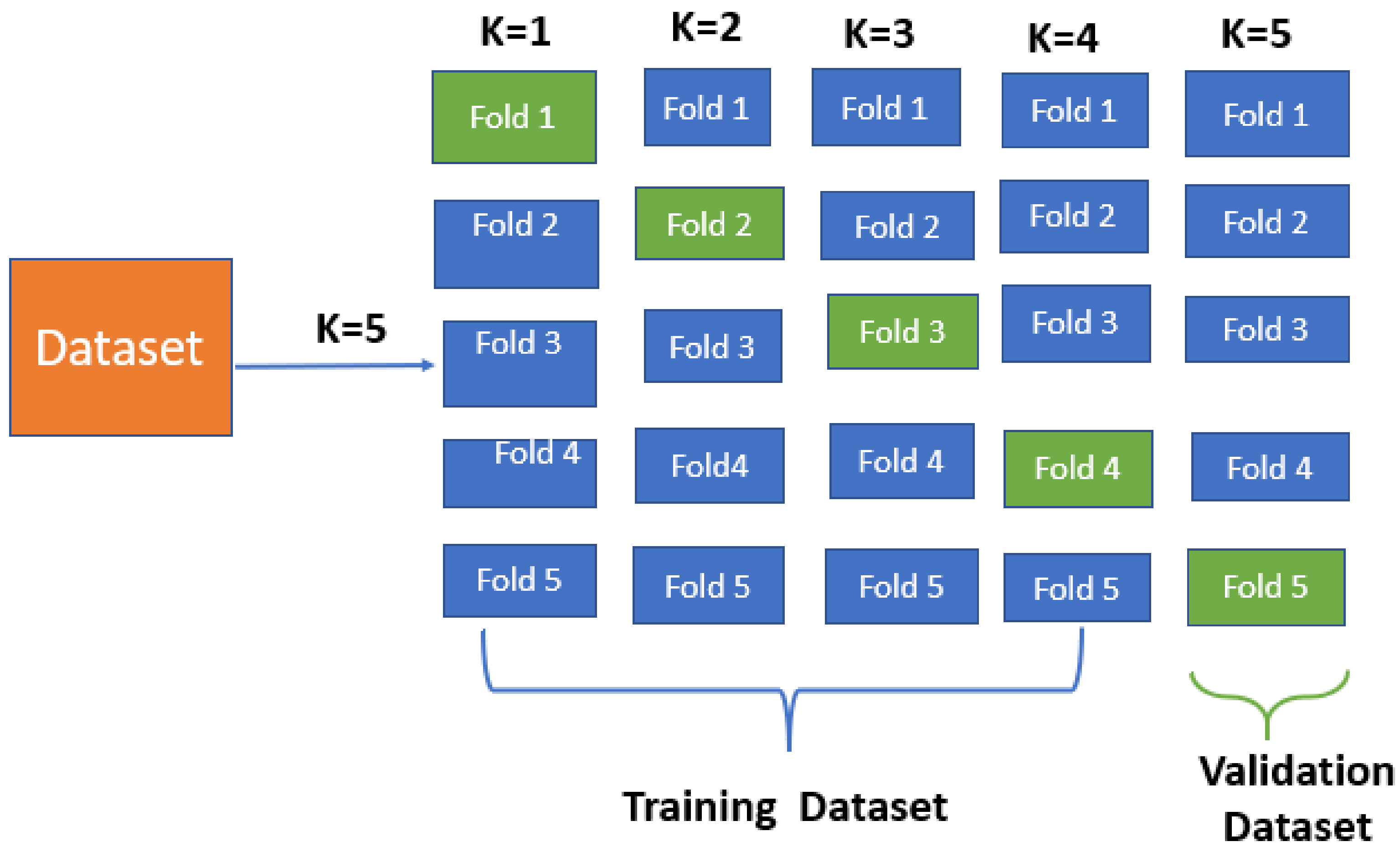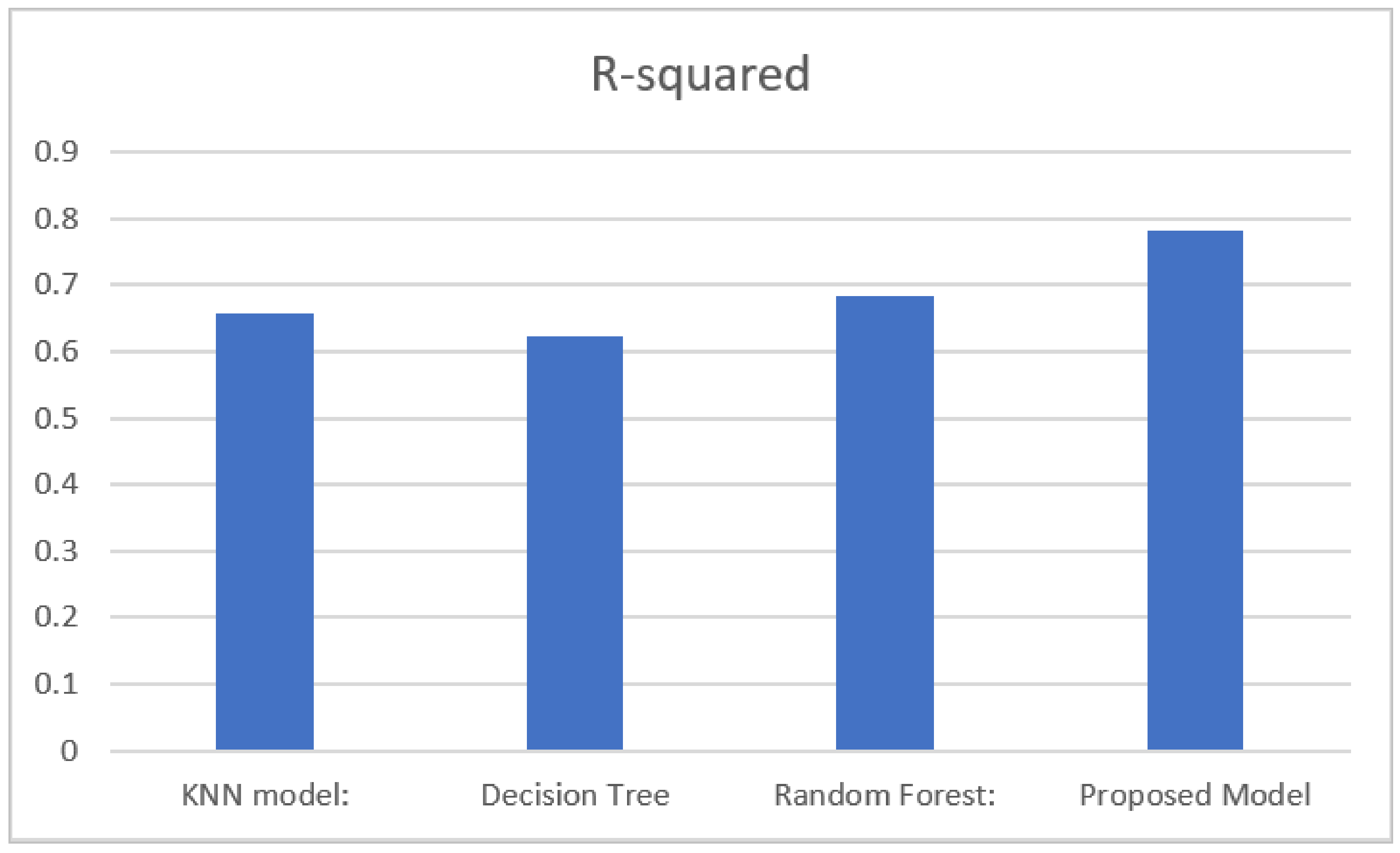Maximizing Biogas Yield Using an Optimized Stacking Ensemble Machine Learning Approach
Abstract
1. Introduction
2. Materials and Methods
2.1. Data Collection
2.2. Machine Learning Models
2.2.1. K-Nearest Neighbor (KNN)
2.2.2. Random Forest
2.2.3. Decision Tree
2.2.4. Light Gradient-Boosting Machine (LightGBM)
2.2.5. Gradient Boosting (CatBoost)
2.2.6. Evolutionary Strategy
Proposed Triadic Ensemble Model
2.3. Evaluation Metrics
2.4. Hyperparameter Optimization
- Learning rate: [0.01, 0.1];
- Number of estimators: sp_randint(100, 1000);
- Maximum depth: sp_randint(3, 8).
3. Results and Discussion
3.1. Proposed Model Prediction Results
3.2. Comparative Analysis of Machine Learning Models
3.2.1. Accuracy of the Model (RMSE and MAE)
3.2.2. Model Fit (R-Squared)
3.3. Variable Importance
4. Conclusions
Author Contributions
Funding
Institutional Review Board Statement
Informed Consent Statement
Data Availability Statement
Conflicts of Interest
References
- National Grid Group. What Is Biogas? Available online: https://www.nationalgrid.com/stories/energy-explained/what-is-biogas (accessed on 19 October 2023).
- Afotey, B.; Sarpong, G.T. Estimation of biogas production potential and greenhouse gas emissions reduction for sustainable energy management using intelligent computing technique. Meas. Sens. 2023, 25, 100650. [Google Scholar] [CrossRef]
- Kang, S.; Kim, G.; Jeon, E.-C. Ammonia Emission Estimation of Biogas Production Facilities in South Korea: Consideration of the Emission Factor Development. Appl. Sci. 2023, 13, 6203. [Google Scholar] [CrossRef]
- Saraswat, M.; Garg, M.; Bhardwaj, M.; Mehrotra, M.; Singhal, R. Impact of variables affecting biogas production from biomass. IOP Conf. Series Mater. Sci. Eng. 2019, 691, 012043. [Google Scholar] [CrossRef]
- Malet, N.; Pellerin, S.; Nesme, T. Agricultural biomethane production in France: A spatially-explicit estimate. Renew. Sustain. Energy Rev. 2023, 185, 113603. [Google Scholar] [CrossRef]
- Bumharter, C.; Bolonio, D.; Amez, I.; Martínez, M.J.G.; Ortega, M.F. New opportunities for the European Biogas industry: A review on current installation development, production potentials and yield improvements for manure and agricultural waste mixtures. J. Clean. Prod. 2023, 388, 135867. [Google Scholar] [CrossRef]
- Sudiartha, G.A.W.; Imai, T.; Mamimin, C.; Reungsang, A. Effects of Temperature Shifts on Microbial Communities and Biogas Production: An In-Depth Comparison. Fermentation 2023, 9, 642. [Google Scholar] [CrossRef]
- Møller, H.B.; Sørensen, P.; Olesen, J.E.; Petersen, S.O.; Nyord, T.; Sommer, S.G. Agricultural Biogas Production—Climate and Environmental Impacts. Sustainability 2022, 14, 1849. [Google Scholar] [CrossRef]
- Gopal, L.C.; Govindarajan, M.; Kavipriya, M.; Mahboob, S.; Al-Ghanim, K.A.; Virik, P.; Ahmed, Z.; Al-Mulhm, N.; Senthilkumaran, V.; Shankar, V. Optimization strategies for improved biogas production by recycling of waste through response surface methodology and artificial neural network: Sustainable energy perspective research. J. King Saud Univ.-Sci. 2021, 33, 101241. [Google Scholar] [CrossRef]
- Induchoodan, T.G.; Haq, I.; Kalamdhad, A.S. Factors affecting anaerobic digestion for biogas production: A review. Adv. Org. Waste Manag. Sustain. Pract. Approaches 2022, 223–233. [Google Scholar] [CrossRef]
- Kunatsa, T.; Zhang, L.; Xia, X. Biogas potential determination and production optimisation through optimal substrate ratio feeding in co-digestion of water hyacinth, municipal solid waste and cow dung. Biofuels 2022, 13, 631–641. [Google Scholar] [CrossRef]
- Artificial Intelligence in Renewable Energy Market Size, Share 2023 to 2032. Available online: https://www.precedenceresearch.com/artificial-intelligence-in-renewable-energy-market (accessed on 20 October 2023).
- Shaw, R.N.; Ghosh, A.; Mekhilef, S.; Balas, V.E. Applications of AI and IOT in Renewable Energy; Elsevier BV: Amsterdam, The Netherlands, 2022; ISBN 9780323916998. [Google Scholar]
- Lyu, W.; Liu, J. Artificial Intelligence and emerging digital technologies in the energy sector. Appl. Energy 2021, 303, 117615. [Google Scholar] [CrossRef]
- Onu, P.; Mbohwa, C.; Pradhan, A. Artificial intelligence-based IoT-enabled biogas production. In Proceedings of the 2023 International Conference on Control, Automation and Diagnosis, ICCAD 2023, Rome, Italy, 10–12 May 2023. [Google Scholar] [CrossRef]
- Yang, Y.; Zheng, S.; Ai, Z.; Jafari, M.M.M. On the Prediction of Biogas Production from Vegetables, Fruits, and Food Wastes by ANFIS- and LSSVM-Based Models. BioMed Res. Int. 2021, 2021, 9202127. [Google Scholar] [CrossRef] [PubMed]
- Kour, V.P.; Arora, S. Particle Swarm Optimization Based Support Vector Machine (P-SVM) for the Segmentation and Classification of Plants. IEEE Access 2019, 7, 29374–29385. [Google Scholar] [CrossRef]
- Meza, J.K.S.; Yepes, D.O.; Rodrigo-Ilarri, J.; Rodrigo-Clavero, M.-E. Comparative Analysis of the Implementation of Support Vector Machines and Long Short-Term Memory Artificial Neural Networks in Municipal Solid Waste Management Models in Megacities. Int. J. Environ. Res. Public Health 2023, 20, 4256. [Google Scholar] [CrossRef] [PubMed]
- Chen, W.-Y.; Chan, Y.J.; Lim, J.W.; Liew, C.S.; Mohamad, M.; Ho, C.-D.; Usman, A.; Lisak, G.; Hara, H.; Tan, W.-N. Artificial Neural Network (ANN) Modelling for Biogas Production in Pre-Commercialized Integrated Anaerobic-Aerobic Bioreactors (IAAB). Water 2022, 14, 1410. [Google Scholar] [CrossRef]
- Chiu, M.-C.; Wen, C.-Y.; Hsu, H.-W.; Wang, W.-C. Key wastes selection and prediction improvement for biogas production through hybrid machine learning methods. Sustain. Energy Technol. Assess. 2022, 52, 102223. [Google Scholar] [CrossRef]
- Renard, B.; Kavetski, D.; Kuczera, G.; Thyer, M.; Franks, S.W. Understanding predictive uncertainty in hydrologic modeling: The challenge of identifying input and structural errors. Water Resour. Res. 2010, 46, W05521. [Google Scholar] [CrossRef]
- Amina, M.K.; Chithra, N.R. Predictive uncertainty assessment in flood forecasting using quantile regression. H2Open J. 2023, 6, 477–492. [Google Scholar] [CrossRef]
- Gupta, A.; Jain, V.; Singh, A. Stacking Ensemble-Based Intelligent Machine Learning Model for Predicting Post-COVID-19 Complications. New Gener. Comput. 2022, 40, 987–1007. [Google Scholar] [CrossRef]
- Meharie, M.G.; Mengesha, W.J.; Gariy, Z.A.; Mutuku, R.N. Application of stacking ensemble machine learning algorithm in predicting the cost of highway construction projects. Eng. Constr. Archit. Manag. 2022, 29, 2836–2853. [Google Scholar] [CrossRef]
- Li, J.; Zhang, L.; Li, C.; Tian, H.; Ning, J.; Zhang, J.; Tong, Y.W.; Wang, X. Data-Driven Based In-Depth Interpretation and Inverse Design of Anaerobic Digestion for CH4-Rich Biogas Production. ACS ES&T Eng. 2022, 2, 642–652. [Google Scholar] [CrossRef]
- Zhang, Y.; Zhao, Y.; Feng, Y.; Yu, Y.; Li, Y.; Li, J.; Ren, Z.; Chen, S.; Feng, L.; Pan, J.; et al. Novel Intelligent System Based on Automated Machine Learning for Multiobjective Prediction and Early Warning Guidance of Biogas Performance in Industrial-Scale Garage Dry Fermentation. ACS ES&T Eng. 2023. [Google Scholar] [CrossRef]
- Mukasine, A.; Sibomana, L.; Jayavel, K.; Nkurikiyeyezu, K.; Hitimana, E. Correlation Analysis Model of Environment Parameters Using IoT Framework in a Biogas Energy Generation Context. Futur. Internet 2023, 15, 265. [Google Scholar] [CrossRef]
- Mapundu, M.T.; Kabudula, C.W.; Musenge, E.; Olago, V.; Celik, T. Explainable Stacked Ensemble Deep Learning (SEDL) Framework to Determine Cause of Death from Verbal Autopsies. Mach. Learn. Knowl. Extr. 2023, 5, 1570–1588. [Google Scholar] [CrossRef]
- Bansal, M.; Goyal, A.; Choudhary, A. A comparative analysis of K-Nearest Neighbor, Genetic, Support Vector Machine, Decision Tree, and Long Short Term Memory algorithms in machine learning. Decis. Anal. J. 2022, 3, 100071. [Google Scholar] [CrossRef]
- KNN Algorithm|Latest Guide to K-Nearest Neighbors. Available online: https://www.analyticsvidhya.com/blog/2018/03/introduction-k-neighbours-algorithm-clustering/ (accessed on 29 November 2023).
- Atmanspacher, H.; Martin, M. Correlations and How to Interpret Them. Information 2019, 10, 272. [Google Scholar] [CrossRef]
- Decision Tree Algorithm—A Complete Guide—Analytics Vidhya. Available online: https://www.analyticsvidhya.com/blog/2021/08/decision-tree-algorithm/ (accessed on 29 November 2023).
- Ke, G.; Meng, Q.; Finley, T.; Wang, T.; Chen, W.; Ma, W.; Ye, Q.; Liu, T.Y. LightGBM: A Highly Efficient Gradient Boosting Decision Tree. Adv. Neural Inf. Process Syst. 2017, 30. Available online: https://github.com/Microsoft/LightGBM (accessed on 28 October 2023).
- Wang, D.-N.; Li, L.; Zhao, D. Corporate finance risk prediction based on LightGBM. Inf. Sci. 2022, 602, 259–268. [Google Scholar] [CrossRef]
- Li, Z.; Wang, W.; Ji, X.; Wu, P.; Zhuo, L. Machine learning modeling of water footprint in crop production distinguishing water supply and irrigation method scenarios. J. Hydrol. 2023, 625, 130171. [Google Scholar] [CrossRef]
- Zhou, Y.; Wang, W.; Wang, K.; Song, J. Application of LightGBM Algorithm in the Initial Design of a Library in the Cold Area of China Based on Comprehensive Performance. Buildings 2022, 12, 1309. [Google Scholar] [CrossRef]
- How LightGBM Algorithm Works—ArcGIS Pro|Documentation. Available online: https://pro.arcgis.com/en/pro-app/latest/tool-reference/geoai/how-lightgbm-works.htm (accessed on 23 October 2023).
- How CatBoost Algorithm Works—ArcGIS Pro|Documentation. Available online: https://pro.arcgis.com/en/pro-app/latest/tool-reference/geoai/how-catboost-works.htm (accessed on 23 October 2023).
- Xiang, W.; Xu, P.; Fang, J.; Zhao, Q.; Gu, Z.; Zhang, Q. Multi-dimensional data-based medium- and long-term power-load forecasting using double-layer CatBoost. Energy Rep. 2022, 8, 8511–8522. [Google Scholar] [CrossRef]
- Wang, D.; Qian, H. CatBoost-Based Automatic Classification Study of River Network. ISPRS Int. J. Geo-Inf. 2023, 12, 416. [Google Scholar] [CrossRef]
- Beyer, H.-G.; Schwefel, H.-P. Evolution strategies—A comprehensive introduction. Nat. Comput. 2002, 1, 3–52. [Google Scholar] [CrossRef]
- Wang, Y.; Li, T.; Liu, X.; Yao, J. An adaptive clonal selection algorithm with multiple differential evolution strategies. Inf. Sci. 2022, 604, 142–169. [Google Scholar] [CrossRef]
- Lange, R.T. evosax: JAX-Based Evolution Strategies. In Proceedings of the GECCO 2023 Companion—2023 Genetic and Evolutionary Computation Conference Companion, Lisbon Portugal, 15–19 July 2023; pp. 659–662. [Google Scholar] [CrossRef]
- Performance Metrics in Machine Learning [Complete Guide]—Neptune.Ai. Available online: https://neptune.ai/blog/performance-metrics-in-machine-learning-complete-guide (accessed on 29 November 2023).
- Evaluation Metrics|12 Must-Know ML Model Evaluation Metrics. Available online: https://www.analyticsvidhya.com/blog/2019/08/11-important-model-evaluation-error-metrics/#Root_Mean_Squared_Error_(RMSE) (accessed on 29 November 2023).
- Metrics to Evaluate your Machine Learning Algorithm|by Aditya Mishra|Towards Data Science. Available online: https://towardsdatascience.com/metrics-to-evaluate-your-machine-learning-algorithm-f10ba6e38234 (accessed on 29 November 2023).






| Variables | Description | Unit |
|---|---|---|
| Moisture level | Moisture level of substances | % |
| temp_out | Ambient temperature of the digester | °C |
| temp_in | Temperature inside the digester | °C |
| pH | Quantitative scale of acidity and alkalinity of solutions of chemical compounds | log10[a(H+) |
| gaz_change | Unit of volume of process gasses | dm3 |
|
| Fold | RMSE | MAE | R-Squared |
|---|---|---|---|
| 1 | 0.0043 | 0.0020 | 0.7670 |
| 2 | 0.0044 | 0.0026 | 0.7951 |
| 3 | 0.0041 | 0.0021 | 0.8153 |
| 4 | 0.0037 | 0.0025 | 0.7702 |
| 5 | 0.0035 | 0.0027 | 0.7899 |
| Average | 0.0040 | 0.0024 | 0.7875 |
| Model | RMSE | MAE | R-Squared |
|---|---|---|---|
| KNN model | 0.0059 | 0.0048 | 0.6541 |
| Decision tree | 0.0062 | 0.0050 | 0.6241 |
| Random forest | 0.0056 | 0.0045 | 0.6863 |
| Proposed model | 0.0040 | 0.0024 | 0.7875 |
Disclaimer/Publisher’s Note: The statements, opinions and data contained in all publications are solely those of the individual author(s) and contributor(s) and not of MDPI and/or the editor(s). MDPI and/or the editor(s) disclaim responsibility for any injury to people or property resulting from any ideas, methods, instructions or products referred to in the content. |
© 2024 by the authors. Licensee MDPI, Basel, Switzerland. This article is an open access article distributed under the terms and conditions of the Creative Commons Attribution (CC BY) license (https://creativecommons.org/licenses/by/4.0/).
Share and Cite
Mukasine, A.; Sibomana, L.; Jayavel, K.; Nkurikiyeyezu, K.; Hitimana, E. Maximizing Biogas Yield Using an Optimized Stacking Ensemble Machine Learning Approach. Energies 2024, 17, 364. https://doi.org/10.3390/en17020364
Mukasine A, Sibomana L, Jayavel K, Nkurikiyeyezu K, Hitimana E. Maximizing Biogas Yield Using an Optimized Stacking Ensemble Machine Learning Approach. Energies. 2024; 17(2):364. https://doi.org/10.3390/en17020364
Chicago/Turabian StyleMukasine, Angelique, Louis Sibomana, Kayalvizhi Jayavel, Kizito Nkurikiyeyezu, and Eric Hitimana. 2024. "Maximizing Biogas Yield Using an Optimized Stacking Ensemble Machine Learning Approach" Energies 17, no. 2: 364. https://doi.org/10.3390/en17020364
APA StyleMukasine, A., Sibomana, L., Jayavel, K., Nkurikiyeyezu, K., & Hitimana, E. (2024). Maximizing Biogas Yield Using an Optimized Stacking Ensemble Machine Learning Approach. Energies, 17(2), 364. https://doi.org/10.3390/en17020364









